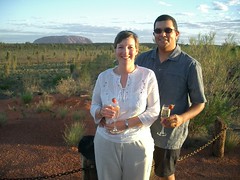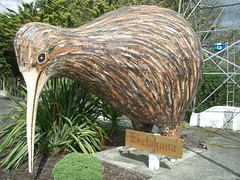Sunday, December 25, 2005
Merry Christmas from 'Sunny' Adelaide
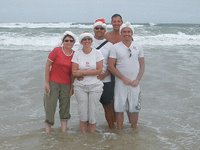 Merry Christmas! We decided that as we were in Australia, we ought to go down to the beach for a Christmas day picture. Unfortunately, even though the temperature has been as high as 38 degrees in the past few days, it started to rain as soon as we got into the sea. So we won't be spending the whole day on the beach.
Merry Christmas! We decided that as we were in Australia, we ought to go down to the beach for a Christmas day picture. Unfortunately, even though the temperature has been as high as 38 degrees in the past few days, it started to rain as soon as we got into the sea. So we won't be spending the whole day on the beach.It still looks like being a nice day though, so we hope you all have a very happy Christmas wherever you are (and however bad the weather may be!).
Sunday, December 18, 2005
Been to Fiji?
 On our way through back through Nadi we got to see Denerau Island, which is a developing cluster of foreign owned 5 star hotels and golf courses just a few miles from the airport. It’s very sad to think that some people who tell you that they have “been to Fiji” will have got off the plane, travelled by air-conditioned coach through the secure gated entrance, and then spent a week on the golf course before being whisked back to the airport. This certainly wasn’t what we came to do.....
On our way through back through Nadi we got to see Denerau Island, which is a developing cluster of foreign owned 5 star hotels and golf courses just a few miles from the airport. It’s very sad to think that some people who tell you that they have “been to Fiji” will have got off the plane, travelled by air-conditioned coach through the secure gated entrance, and then spent a week on the golf course before being whisked back to the airport. This certainly wasn’t what we came to do.....Well, we can’t exactly claim to have ‘roughed it’, neither can we say that we have visited a large number of islands or any of the more remote islands. In two weeks we have visited 8 towns, on four different islands (which means that we only have about another 100 inhabited islands to visit in the future) and have seen everything from small Fijian villages to busy market towns which seem as if they could easily be on the coast of the Indian Ocean rather than the Pacific.
So, we’ve certainly not seen it all, and we can’t claim to be experts, but we can definitely say that we’ve “been to Fiji”!
Saturday, December 17, 2005
Lautoka
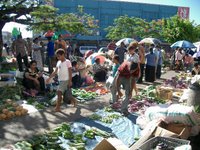 After a quick stop at Nadi to leave our luggage at the airport we take the 15 mile journey to Fiji’s 2nd largest city for our final night.
After a quick stop at Nadi to leave our luggage at the airport we take the 15 mile journey to Fiji’s 2nd largest city for our final night.Once again it is a town with relatively few tourists but we arrive on Saturday afternoon and the market is in full swing, both indoors and outside on the pavements. The whole range of local produce is available, although it seems that many of the adjacent vendors are all selling exactly the same selection, so we’re not sure whether the locals just buy from anyone or whether they have ‘favourites’.
It turns out that the hotel we are staying in is hosting a 50th birthday party by the swimming pool tonight. Lovely. You also may, or may not, be surprised to hear that Fijian DJ’s play almost exactly the same selection of music at such events as their English counterparts (Dancing Queen anyone?!).
Something else we noticed today (although it is certainly not unique to Lautoka) is that Fiji has a litter problem. Since we first arrived we have seen signs in the bigger towns urging people to ‘Keep Fiji Beautiful’. In some places this is a little difficult as there aren’t always bins around, but on buses litter seems to get dropped on the floor or even blatantly chucked out of the window!
Thursday, December 15, 2005
Sigatoka Sand Dunes
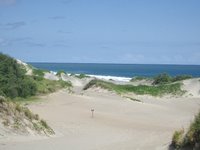 We had thought that we would need to book an organised trip to visit these dunes, but since we are now becoming quite used to the buses and taxis we put together a DIY excursion. Since we managed to do it for just over £4 each (including a bus and taxi in each direction, park entry fee and lunch) it’s safe to assume that an organised trip would have cost a little more.
We had thought that we would need to book an organised trip to visit these dunes, but since we are now becoming quite used to the buses and taxis we put together a DIY excursion. Since we managed to do it for just over £4 each (including a bus and taxi in each direction, park entry fee and lunch) it’s safe to assume that an organised trip would have cost a little more.The dunes themselves are quite interesting, and hard work to climb if you choose to turn up in the middle of the day as we did. But somehow I wasn’t as impressed as I expected to be, I’m sure I’ve seen similarly big piles of sand on beaches elsewhere!
More interesting are the archaeological finds that have been made here. Bones and pot fragments have been dated at 3000 years old and have shed light on the movements of people around the pacific in those times.
Coral Coast
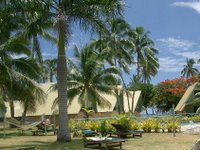 Along the southern coast of Viti Levu is an area known as the Coral Coast. This is because of the reef in the area, but probably also has something to do with being a fancy name for an area where there are some very fancy resorts. Since we are poor, unemployed travellers(!) we are of course not staying in a fancy resort. Not that you’d know it from a quick glance at the place we stayed, a kind of budget-backpacker-beach-resort! We still had a nice bungalow in front of the pool and only about 30 seconds from the beach.
Along the southern coast of Viti Levu is an area known as the Coral Coast. This is because of the reef in the area, but probably also has something to do with being a fancy name for an area where there are some very fancy resorts. Since we are poor, unemployed travellers(!) we are of course not staying in a fancy resort. Not that you’d know it from a quick glance at the place we stayed, a kind of budget-backpacker-beach-resort! We still had a nice bungalow in front of the pool and only about 30 seconds from the beach.No ‘Butlins Style’ organised activities here, just the beach and the pool. They did show Blackadder on DVD in the TV room in the evening though. They also lent out snorkelling gear for free. No need for boat trips here, just wander out from the beach and within about 6ft of the low tide mark you find many brightly coloured fish.
After another few feet it was deep enough to swim in and we probably spent a good 90 minutes within 50ft of the shore. Plenty more fish here and another black and white sea snake. Also some scary looking snake-like things which we have guessed to be some kind of coral at the moment (until we discover that they are deadly poisonous and we are lucky to be alive!). Out at the farthest point that we snorkelled to we discovered that the reef is receiving some artificial assistance. What appear to be old wooden tables have been sunk into the seabed and covered a wire grid (or perhaps a piece of fencing), new coral is already growing and the fish seem quite happy with it all. Eventually we decide that it’s time to return to shore and end our last snorkel adventure for this part of the trip. Once again we have no pictures, but when there’s time we may search the internet for some examples of what we’ve seen so far......
Wednesday, December 14, 2005
Suva
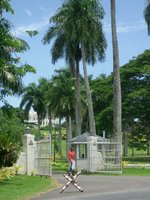 With 170,000 residents, the capital is home to a fifth of the entire population of Fiji. It has many of the same facilities (and problems) of other major cites, and for the first time since we left North America we encounter people (who may or may not be homeless) asking for money in the street. This feels particularly out of place here where the traditional village life seems to involve everyone helping each other out.
With 170,000 residents, the capital is home to a fifth of the entire population of Fiji. It has many of the same facilities (and problems) of other major cites, and for the first time since we left North America we encounter people (who may or may not be homeless) asking for money in the street. This feels particularly out of place here where the traditional village life seems to involve everyone helping each other out.There are also, of course, McDonalds and KFC but why would you want to visit them when better (and cheaper) food is available almost everywhere you look?
We are now on the wetter east side of Viti Levu and we are welcomed by very heavy afternoon rain for an hour or so, although this does at least seem to reduce the humidity for a short while afterwards.
The guidebooks and hotels all warn you that, despite the legendary Fijian friendliness, there is a strong chance that anyone who greets you in the street in Suva itself will probably be trying to sell you something. This will generally turn out to be a wooden carved sword or mask. It doesn’t take us too long to get singled out as tourists!
As it happens, the man who ‘targets’ us (and claims to be just waiting for a bus back to his village, yeah right) gives us quite an informative little tour around the area of the parliament and government building. So we have visited the site of at least one of the coups in the messy saga that is recent Fijian history. Unfortunately (for him) our opportunist ‘guide’ has met his match in a tourist who has inherited a (possibly Fijian) determination to not get ripped off, so when we finally manage to shake him off and he suddenly offers us a ‘gift’ to take home he is swiftly dispatched!
Monday, December 12, 2005
Levuka
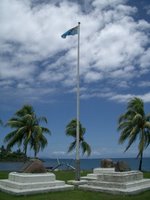 After our second night in Savusavu we left early to fly to Levuka. Because of the infrequent flights we had to fly to Suva and then wait about 6 hours for our connecting flight of only 12 minutes!
After our second night in Savusavu we left early to fly to Levuka. Because of the infrequent flights we had to fly to Suva and then wait about 6 hours for our connecting flight of only 12 minutes!Levuka is on the small island of Ovalau and was Fiji’s capital until 1882, when the British decided that lack of space for town expansion meant that Suva was a better location. At the edge of town is the cession site, where Fiji first became a British colony in 1874 and then gained its independence some 96 years later.
Much of Levuka is still as it was in the 1800’s, with old wooden buildings lining the main street. The town has been nominated to be a world heritage site, although it’s not clear how long it takes to agree these things. There have apparently been a number of fires in recent years that destroyed buildings of interest.
We stayed in the Royal Hotel which proudly claims to be Fiji’s oldest. The prices don’t seem to have changed much over the years as this turns out to be our best bargain so far at £12 for a double room.
This would be another town with no mains electricity supply if it weren’t for the tuna canning plant at the end of the road. I’d never really considered what such a place would look like, and the sight and smell of this one doesn’t encourage me to go looking for any others!
Saturday, December 10, 2005
'Fiji's Finest Bus Journey' (almost)
 We were tempted by the guidebook’s recommendation to take the ‘scenic’ route back to Savusavu, this is a 7 hour journey around half the coastline of Vanua Levu described in the book as ‘Fiji’s finest bus journey’.
We were tempted by the guidebook’s recommendation to take the ‘scenic’ route back to Savusavu, this is a 7 hour journey around half the coastline of Vanua Levu described in the book as ‘Fiji’s finest bus journey’.As exciting as this sounds we were overcome by sanity, and decided that we couldn’t cope with a whole day on a bus as overloaded as the one we arrived on. So we opted to return along the same route and take more photos from the other side of the bus.
It’s a little sad to see that all the signs announcing the name of each village are heavily sponsored by Coca Cola. I’d like to think that they’ve paid handsomely for the privilege, but somehow I doubt that this is the case. In fact, we realise at this point that we haven’t seen any Pepsi whatsoever since we arrived in Fiji. Hmmmm.......
Labasa
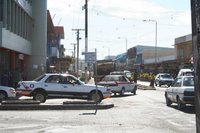 The population here is predominantly Indian and it certainly feels very different from Savusavu. There is a big sugar mill a couple of Km away, and it also seems to be a very busy market town.
The population here is predominantly Indian and it certainly feels very different from Savusavu. There is a big sugar mill a couple of Km away, and it also seems to be a very busy market town.Curry is the easiest meal to find in town, so Nikky gets to experiment further with her least favourite food!
We’re only here for the night as there isn’t a great deal around here, but this does mean yet another insanely low price for a really quite nice hotel.
Friday, December 09, 2005
On the buses
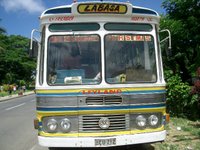 Our next destination was Labasa on the north side of the island. There are two bus routes to get there, and we opted for the shorter two and a half hour trip which travels over the top of the central ridge of mountains.
Our next destination was Labasa on the north side of the island. There are two bus routes to get there, and we opted for the shorter two and a half hour trip which travels over the top of the central ridge of mountains.Now, you can say what you want about the downfall of the British motor industry, but somewhere in the past (40 or 50 years ago by the looks of it) it produced vehicles that are still the backbone of Fiji’s public transport system. They seem to get regular refitting as well, because some buses have brand new seats (in attractive red vinyl!). Excellent air conditioning is also provided by the complete lack of windows on most of them.
Since neither of us are old enough to remember seeing these buses in England we can’t be sure whether the extra seats are a local addition or not. Down one side of the bus each seat has what first appears to be an armrest, when the bus continues to fill up these are then folded down so that the entire centre aisle is full of seated people. In case of emergency we assume you just dive through the non-existent windows!
The only part of the buses which seem to be showing age are the engines and gearboxes, which means that on a journey involving steep hills you are often reduced to little more than a fast walking pace. Perfect for sightseeing and photography! The bus of course stops absolutely everywhere, but we are well adjusted to ‘Fiji Time’ now so we don’t even notice.
About halfway along the route the bus stops for 5 minutes in what seems to be the largest village, this also doubles as the ‘refreshment’ stop as locals crowd around the outside of the bus selling sandwiches, nuts, fruit and drinks.
Savusavu
 On the south side of Vanua Levu this is a small town of 5000 people. It apparently has one of the larger ex-pat communities (Americans and Aussies as far as we could tell), probably due to the marina.
On the south side of Vanua Levu this is a small town of 5000 people. It apparently has one of the larger ex-pat communities (Americans and Aussies as far as we could tell), probably due to the marina.It's a nice place although the only real tourist attraction in town are the hot springs on the side of the hill. As we had now come to expect from Fijian tourist attractions this is just a small roped off area (with a couple of benches) where boiling hot water bubbles out of the ground, not a gift shop in sight!
ADDED 9/1/2006:
A couple of video clips of the hot springs.
Video1
Video2
(Each video is around 2MB, so will take a few minutes to download for those of you with dialup connections)
Thursday, December 08, 2005
Sailing the Pacific (sort of)
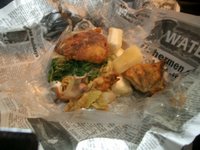 Our next stop was the island of Vanua Levu, but rather than fly again we decided to experience the local ferry service. From Taveuni to the town of Savusavu was a 4 hour journey (this was the fast ferry!). Had we wanted to go all the way to Suva we would have had a couple of stops and a lengthy 23 hour journey.
Our next stop was the island of Vanua Levu, but rather than fly again we decided to experience the local ferry service. From Taveuni to the town of Savusavu was a 4 hour journey (this was the fast ferry!). Had we wanted to go all the way to Suva we would have had a couple of stops and a lengthy 23 hour journey.The locals were selling bargain meals on the dock, which is why the feast in the photo is wrapped in newspaper. The casava was quite nice (tasted a bit like a cross between a boiled potato and parsnip), and we were enjoying the fish until we discovered that the final battered piece was actually the head and only the eyes had been removed!!
It was actually not a bad ferry. It had air conditioning and rows of seats that appeared to have originated on a 70’s airliner. There was even ‘entertainment’ in the form of a dodgy Steven Segal DVD (which really wasn’t suitable for a lunchtime sailing full of kids!)
We were travelling on a Friday afternoon and the boat wasn’t that full, but when we arrived at Savusavu there were literally hundreds of people waiting to board for the overnight journey to Suva. We’re not sure whether this was normal weekend traffic or Christmas shopping ‘Island Style’. It’s also difficult to tell how many people will actually board a plane, bus or boat here, since so many family members seem to turn up to see people off or greet new arrivals.
Wednesday, December 07, 2005
Naselesele School
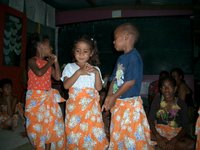 There are many places in Fiji where you can see Meke (traditional dancing) or attend a Lovo feast (the Lovo is the underground ‘oven’ lined with banana leaves). In most cases these are in the larger resort hotels, but sometimes they take place in the villages.
There are many places in Fiji where you can see Meke (traditional dancing) or attend a Lovo feast (the Lovo is the underground ‘oven’ lined with banana leaves). In most cases these are in the larger resort hotels, but sometimes they take place in the villages.We were fortunate to be able to experience the latter and contribute to the local community rather than a foreign hotel company. The wife of our hotel owner was from neighbouring Naselesele village where they are raising funds to rebuild and extend the school. (Apparently they receive some help from New Zealand which sends old school desks when NZ schools are refurbished.)
So, once a week they invite visitors to a Lovo which is prepared by the parents of the schoolchildren. We only expected to have the meal but we were also treated to a singing and dancing performance by the kids themselves. Possibly not as polished a performance as we might see at the Sheraton, but much more worthwhile. The food was excellent, and we even picked up some cooking tips from the ‘chefs’!
Is it today or yesterday?
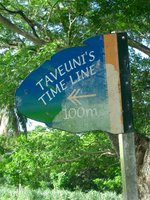 Apparently there are only 4 or 5 places in the world where the 180th meridian crosses land (3 of these are in Fiji), and of all these places the easiest to actually get to (so we’re told) is on Taveuni. This was the site where many photos of the first sunrise of the new millennium were taken.
Apparently there are only 4 or 5 places in the world where the 180th meridian crosses land (3 of these are in Fiji), and of all these places the easiest to actually get to (so we’re told) is on Taveuni. This was the site where many photos of the first sunrise of the new millennium were taken.Although the island seems very proud of this landmark it’s
hidden in the corner of an overgrown rugby field. It is signposted though and have about 5 minutes to take a few pictures before racing back across the field to catch the last bus back.
NOTE: Of course the International dateline doesn’t actually go through Taveuni. If you’ve ever wondered why it has a funny kink in the middle of the Pacific when you look on maps, that’s where it goes around Fiji.
This has only been the case for the past hundred years or so, and prior to that there are entertaining tales of plantation owners observing different days at each side of their land (and therefore forcing the locals to work 7 days a week), and an enterprising shop owner who got around Sunday trading laws by claiming it was Monday at the back of his shop!
Tavoro Waterfalls
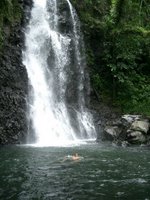 On the edge of the Bouma National Heritage Park area, these are another great example of the local village looking after the park area. There is quite a well maintained path, but we decided quite quickly that the park wouldn’t last very long in the US or UK, since they would be knee deep in lawsuits after the first month from careless visitors who had slipped on steps, knocked their heads on low branches (Nikky has first hand experience of this!), or fallen in the river at the point where you have to cross it using just a rope for support. So please, don’t come here and complain about such things, it’s fine as it is you just need to remember back to the days when you were responsible for your own safety!
On the edge of the Bouma National Heritage Park area, these are another great example of the local village looking after the park area. There is quite a well maintained path, but we decided quite quickly that the park wouldn’t last very long in the US or UK, since they would be knee deep in lawsuits after the first month from careless visitors who had slipped on steps, knocked their heads on low branches (Nikky has first hand experience of this!), or fallen in the river at the point where you have to cross it using just a rope for support. So please, don’t come here and complain about such things, it’s fine as it is you just need to remember back to the days when you were responsible for your own safety!We mentioned this problem with accident claims to our hotelier, and he explained to us that the Fijian approach to such things would be: “Sh*t Happens”. Maybe some of the more ridiculous personal injury claims should be handled in the same way!
After 40 minutes or so of climbing steps in unsuitable weather (Mad dogs & Englishmen and all that) we were in need of a swim in the pool by the second of three falls. The water here is cooler than we have been used to, but still couldn’t be described as ‘cold’ or even ‘chilly’. We didn’t continue to the third falls as we had been tipped off that there wasn’t much water (and we needed to get back down for the bus). After another quick dip at the lower falls we returned to the village to await the return bus.
Since there aren’t many tourists about we are the highlight of the day for the village kids who join us in the bus stop and are fascinated by the chance to see their picture on our cameras (see earlier ‘Taveuni’ note for picture). Our feeling of experiencing ‘real’ village life is somewhat shattered when we realise that one of the boys is wearing a number 23 Real Madrid shirt, proving that you really can’t get away from David Beckham!
Tuesday, December 06, 2005
Language
Just a few basic tips to help you with pronunciation of some of the place names (thanks to a combination of our guidebook and South Pacific phrasebook). The written Fijian you see today was devised by 19th century British missionaries (so blame them for anything you find a little odd!).
So basically, vowel sounds are similar, and generally the penultimate syllable of words is stressed (unless the last vowel is a long vowel). Finally, there are a number of consonants that are pronounced differently than you might expect:
b is pronounced mb
d --------- “ -------- nd
g --------- “ -------- ng (which many of you should already know!)
q --------- “ -------- ngg
c --------- “ -------- th
So:
Beqa is pronounced Mbengga
Nadi --------- “ -------- Nandi
Sigatoka ---- “ -------- Singatoka
So basically, vowel sounds are similar, and generally the penultimate syllable of words is stressed (unless the last vowel is a long vowel). Finally, there are a number of consonants that are pronounced differently than you might expect:
b is pronounced mb
d --------- “ -------- nd
g --------- “ -------- ng (which many of you should already know!)
q --------- “ -------- ngg
c --------- “ -------- th
So:
Beqa is pronounced Mbengga
Nadi --------- “ -------- Nandi
Sigatoka ---- “ -------- Singatoka
Waitabu Marine Reserve
 Quite a large part of Taveuni itself is designated as a national park, but there is also a small offshore area which has been set aside for snorkelling and no fishing is allowed. The reserve is right in front of a local village and it seems that it is the local people who ‘run’ the park. We were dropped off at the park and met by a lady (who turns out to be the snorkel guide) who gave us some snorkel gear (from the village storage shed) and took us through the village to the beach.
Quite a large part of Taveuni itself is designated as a national park, but there is also a small offshore area which has been set aside for snorkelling and no fishing is allowed. The reserve is right in front of a local village and it seems that it is the local people who ‘run’ the park. We were dropped off at the park and met by a lady (who turns out to be the snorkel guide) who gave us some snorkel gear (from the village storage shed) and took us through the village to the beach.There is a small boat which could probably seat about a dozen people, but today it is just us, the guide, the guy in charge of the boat, and a small child who belongs to one of them! The snorkelling here is fantastic and quite possibly the best we have done anywhere (including the barrier reef).
We have seen more fish and bigger fish elsewhere, but the colours here are even more spectacular and the coral seems more untouched. There are large clams with bright green and purple colouring, large conch(?) shells on the seabed, and we even got to see a black and white striped sea snake. The visibility is also really good here so it’s a great shame that we don’t have a competent underwater camera. Maybe next time!
We got to experience some real Fiji village life on this day as we saw people washing in the streams and rivers and whilst we were waiting for our lift to pick us up, we sat in the boat owners house and chatted to him, his wife and the snorkel guide (only really the latter spoke English well), but we managed to have a good chat about how they make the grass ‘Fiji Mats’ as there were some leaves drying outside the house ready to be woven. I’m not sure you could meet a friendlier nation as every where we go people come and shake your hands and call out ‘Bula!’ (Hello) as they pass. It makes a refreshing change from avoiding eye contact on The Tube!
Monday, December 05, 2005
Taveuni
 Our first destination is the island of Taveuni. It takes just over an hour to fly here from Nadi, which includes a stop in Savusavu where the airport ‘terminal’ is about the size of a large bus shelter.
Our first destination is the island of Taveuni. It takes just over an hour to fly here from Nadi, which includes a stop in Savusavu where the airport ‘terminal’ is about the size of a large bus shelter.There are obviously a great many islands here where there are no tourist facilities whatsoever, but we’re not sure that we are up to that. Taveuni seems to be somewhere in between. There are some places to stay, but not very many and most are small with only a handful of rooms.
We think there is still no mains electricity supply here and everything is run by generators. Many of the smaller hotels only run these generators from 6-9 in the evening (although we have been fortunate to end up with 24hr power).
Air Fiji
 Now that our route around the islands is finalised we have booked a few internal flights to get us there. These are certainly the smallest commercial planes that either of us have ever flown on. It’s also quite a novelty to discover that after you have checked your bags in, you then have to get on the scales yourself. Once this has been done the check-in man can do some sums and figure out whether or not they can take any other freight on the flight! There were only 15 seats and although there was a safety briefing of sorts from the co-pilot, he may as well have said “...look, you know what to do...”!!
Now that our route around the islands is finalised we have booked a few internal flights to get us there. These are certainly the smallest commercial planes that either of us have ever flown on. It’s also quite a novelty to discover that after you have checked your bags in, you then have to get on the scales yourself. Once this has been done the check-in man can do some sums and figure out whether or not they can take any other freight on the flight! There were only 15 seats and although there was a safety briefing of sorts from the co-pilot, he may as well have said “...look, you know what to do...”!!Sunday, December 04, 2005
Nadi
 After a trip back to the airport travel office to book some more hotels (and for Mark’s first ever experience of not having to spell his name for someone after saying it!), we headed into town on the bus. Fiji is proving to be significantly cheaper than our previous stops and the bus journey costs only 70 cents each (about 24p).
After a trip back to the airport travel office to book some more hotels (and for Mark’s first ever experience of not having to spell his name for someone after saying it!), we headed into town on the bus. Fiji is proving to be significantly cheaper than our previous stops and the bus journey costs only 70 cents each (about 24p).Since we have arrived on a Sunday lots of places are closed. Downtown Nadi is also not that big so it doesn’t take us too long to wander around and have a look at all the shops we could have visited if we’d arrived on a weekday! The market here is apparently worth a visit, but on Sunday there are just a few people outside in the street selling pineapples.
Although Nadi is Fiji’s 3rd largest city (pop. 32,000) this is probably largely because it supports the international airport, it still feels like a very small place with many of the shops and cafes obviously aimed at the backpackers who are passing through at the beginning or end of their visit.
Fiji
 On arrival at Nadi we discovered that we had been a little too laid back about arranging our accommodation. You can make internet bookings for many places here, but it seems that what then happens is that somebody prints off your request during office hours (Mon-Fri!) and makes the arrangements by phone.
On arrival at Nadi we discovered that we had been a little too laid back about arranging our accommodation. You can make internet bookings for many places here, but it seems that what then happens is that somebody prints off your request during office hours (Mon-Fri!) and makes the arrangements by phone.This was our first proper encounter with ‘Island Time’, since in Tahiti it seemed to involve taxis and buses arriving to collect you early rather than late.
None of this was really a problem though as the travel offices at the airport are open 24 hours a day and they will happily phone around and find you a hotel (see photo). So without too much delay we were on our way to our accommodation (apologies to the bus load of backpackers who were kept waiting on the minibus whilst we finalised our booking!).
Saturday, December 03, 2005
Whoooosh! ......There goes Saturday!
 Most international flights around here seem to be in the middle of the night. This has it’s downsides, but it probably minimises the confusion caused by losing a whole day when flying west across the dateline. Having said that even the pilot needed two or three attempts to tell us what the day and time would be when we arrived in Fiji!!
Most international flights around here seem to be in the middle of the night. This has it’s downsides, but it probably minimises the confusion caused by losing a whole day when flying west across the dateline. Having said that even the pilot needed two or three attempts to tell us what the day and time would be when we arrived in Fiji!!So we checked in at 10:30 on Friday night, boarded the plane just before midnight, and after a four hour flight we arrived in Fiji at 2am on Sunday. It’s quite a small plane for a 4 hour flight (with no comfy seats up the front!) but Mark’s many hours of internet research paid off once again as he managed to secure one of only two emergency exit seats on the plane that had no seat in front of them.
